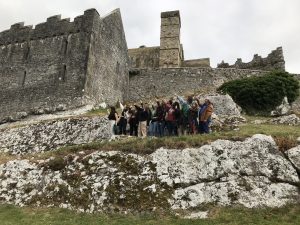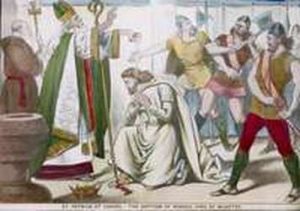11 Chapter Eleven: The Rock of Cashel
Smyth, Daragh. Earthing the Myths: The Myths,Legends and Early History of Ireland. Irish Academic Press.

Less than twenty miles north-east of Slievenamuck is the town of Cashel [66], from caiseal or ‘stone fort’. There are up to eighty caiseals in Ireland, mostly in the west and north-west. Of these forts, Cashel in Tipperary is by far the most important. It is known both as Caiseal Mumhan, ‘Cashel of Munster’ and as Caiseal na Ríogh, ‘Cashel of the Kings’, as it was the royal seat of the Kings of Munster. A local name is Carraig Phádraig or ‘St Patrick’s Rock’. Legend states that St Patrick in clearing out satanic practices threw part of the mountain known as the Devil’s Bit [59] as far as Cashel, thus forming the Rock of Cashel. A gold vessel of the Hallstatt type was found on the Devil’s Bit in 1692; the Celts brought the Hallstatt culture to Ireland in the third century BC, and the gold vessel may have been used for ceremonial purposes and eventually buried with a noted king or queen.
The origin legend of the kingship of Cashel claimed that Cashel was founded by Conall Corc, son of a British mother and distant relation of Eógan of the Eóganacht.

During the fifth century St Patrick converted Aengus son of Nadfraoch while he was king and baptised him at Cashel. A story much told about the initiation of Aengus into Christianity is included in the following verse from Keating’s History of Ireland:
Tré bhonn Aonghuis anba an bhroid, Do chuaidh rinn bhaichle bPádroig; Gur líon an t-urlár da fhuil, An gníomh ní cómhrádh coguir.
Through the foot of Aengus, great the discomfort, Went the point of Patrick’s crozier; So that the floor was covered with his blood, The deed is no whispered gossip. [Translated by P.S. Dinneen]
It is generally thought now that the above injury was an error, and that Aengus remained quiet as he thought it was part of the ritual. That Cashel was the inaugural centre for the kings of Munster is evidenced by its possession of an inaugural stone and the presence of a goddess represented by a Síle na Gig, a fertility figure in stone that is associated with pagan cults. Part of the inaugural ceremony was the symbolic mating of the king with the goddess as represented by the Síle (see Sheela-na-gig-at-Cashel). This part of the rite is supported by a verse from the Dindshenchas* as follows:
Atbér-sa, a mac mín: limas fóit na hair-ríg: is mé ind ingen seta seng, flaithius Alban is hÉrend.
I will tell you gentle boy, with me the high kings sleep; I am the graceful, slender girl, the Sovereignty of Scotland and Ireland. [Translated by Edward Gwynn]
Cormac’s chapel, built in the early twelfth century, is regarded as the most interesting Romanesque church in Ireland; it has an arch of stone heads over the altar, reminiscent of the cult of the head and the pre-Christian veneration of the head over the heart. In early Christian times, the
Kings of Cashel were also bishops so that they possessed both a temporal and a spiritual role.
Slievenamon (Sliabh na mBan, ‘mountain of the women’) [67, 75] is a mountain 2,364 feet above sea level, seven miles north-east of Clonmel. Its early literary spelling was Sliab na mban finn or ‘the mountain of the white women’, who were presumably goddesses. Unlike Croagh Patrick, the mountain has preserved its prehistoric sanctity to the present day.
A folktale referring to Slievenamon tells of a race from the base to the summit by a number of women. . . . From amongst the numerous princesses and beautiful young women to whom Finn mac Cumhail had paid attention both in Ireland and foreign nations, he selected twenty-one women, either for their superior personal attractions or for the influence of family connexion, from which to choose his wife, and they were thus to compete for his hand: On an appointed day the twenty-one young women were to stand in a row at the foot of Sliabh na mBan, and upon a given signal to run up the mountain, the first who should arrive at Mullach- Mullach-suide-Finn [the present cairn at the top of the mountain], to become the wife of the king of the Fenians. Finn stood at the summit of the mountain and having blown a loud blast upon his trumpet, the racers set off at full speed. The above is the essence of the story but the race was not entirely fair as Finn favoured Gráinne and Gráinne won the race and became Finn’s wife. This relationship resulted in the birth of Oisín, the poet of the Fianna. Unfortunately, a local man named Diarmuid Uí Duibhne had a ball searc or ‘love spot’ on his breast, and having seen this Gráinne was smitten. This resulted in their famous elopement.
It was at Síd ar Femen that Finn acquired imbas forosnai, ‘the knowledge that illuminates’. This story connects the Fenian tradition with the pre-Christian goddesses, as Finn’s son Oisín is connected to the Christian tradition through his discourses at Ardfert with St Patrick. The Fenian sagas thus have a foot in both camps. At the doorway to the síd, Finn met a fairy woman or banshee who had in her hand a dripping vessel from which she had just distributed drink. She closed the door against Finn, and his finger was jammed between the door and the doorpost. He put his finger into his mouth and achieved fis or wisdom. An earlier version was that he achieved wisdom from drinking from the vessel that the banshee had in her hand.
A more popular story which I learnt at national school was that Finn acquired wisdom from a salmon. The story is that Finn was with a druid, also named Finn, who asked him to catch a salmon and cook it, but not to eat it; this Finn did, but while cooking it he burnt his thumb and while sucking his hot thumb he acquired the imbas forasnai. So, whenever Finn put his finger into mouth, he acquired this particular insight. Another way to obtain enlightenment was to sleep in the hide of a newly slaughtered bull; this form of invocation was also practised in the Highlands of Scotland. Slievenamon is where the great lovers Midir and Étaín flew to in the form of swans. Diarmuid* and Gráinne* also spent time here, and its original function may have been as a fertility centre as well as a centre for poetry and illumination. It is an Otherworld dwelling and an epicentre of our pre-Christian culture.
Burials at Rock of Cashel-1 : Look at burials on page 172.

